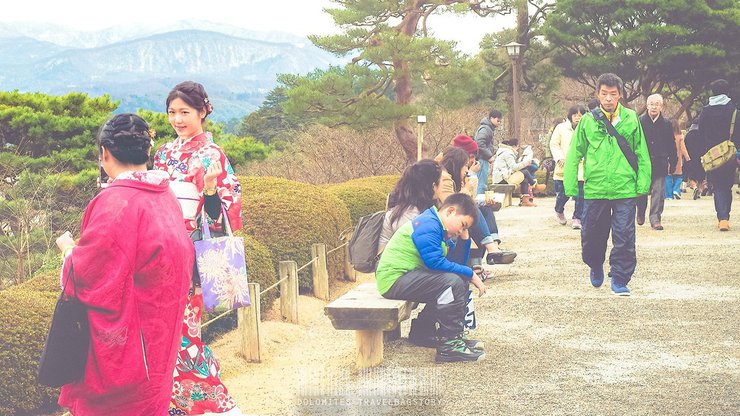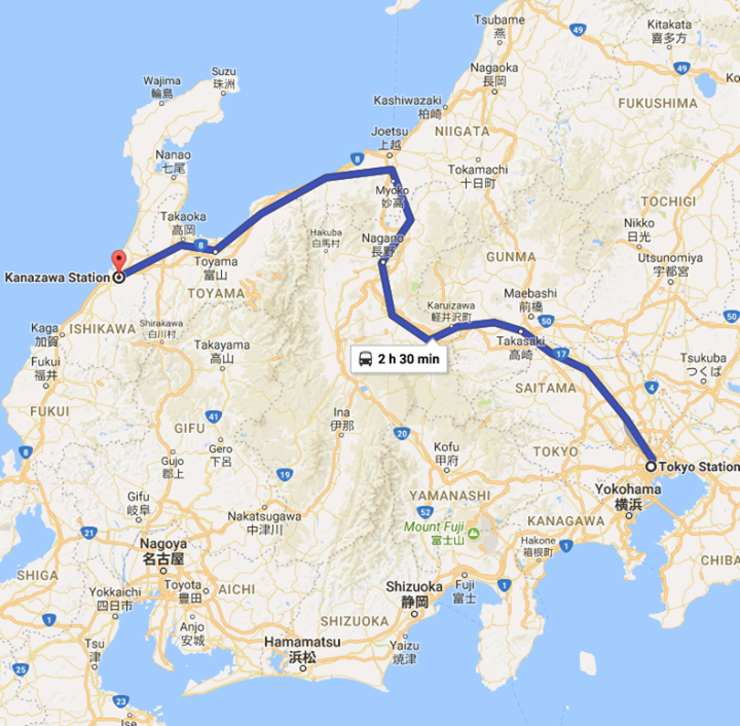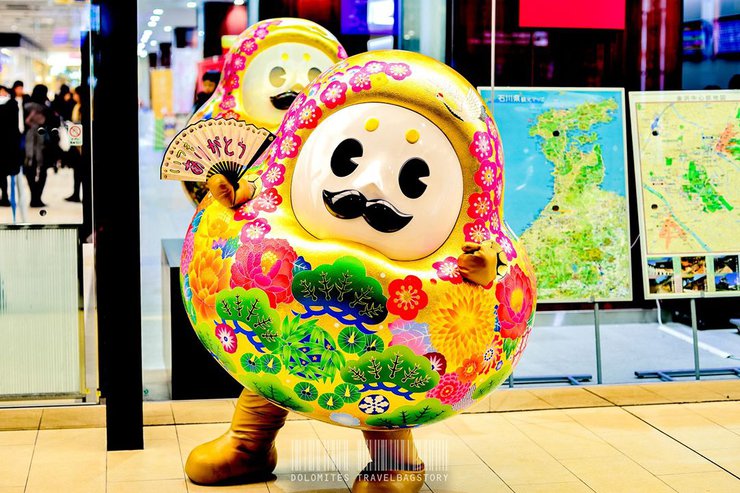Kanazawa, once Japan's largest industrial city during World War I, stands as a historical testament to the defeat of the Western superpower Russia by the small nation of Japan. This victory paved the way for Japan's subsequent rise to prominence in Asia, culminating in its emergence as a major power in World War II.

Today, we will take you to Kanazawa, a city located in the west of Japan on the coast of the Sea of Japan. In the past, not many Thai tourists visited this city. However, in the era of free visas, when Japan has become a popular holiday destination for Thai people, Kanazawa has started to welcome more Thai tourists. In particular, it is a starting point for visiting the World Heritage Site, Shirakawa-go.

Traveling to Kanazawa is very convenient. From Tokyo, take the Hokuriku Shinkansen line, the same line that goes to Karuizawa and Nagano. You can ride directly to Kanazawa Station, which takes about 3.5 hours. Let's follow these cute girls and go together.


We arrived at Kanazawa Station, a large station with a department store and almost everything you could need. The golden Kanazawa-style Daruma doll is like the city's mascot. It's gold because "kana" or "kin" means gold. Kanazawa is most famous for producing the highest quality gold leaf in Japan, which has been used to decorate palaces and temples in Kyoto since ancient times. At the train station, we had to hurry to book a bus to Shirakawa-go. Even though we were traveling before the New Year, after Christmas, we thought the bus might be fully booked. And it was. The bus was booked solid until after the New Year. Oh no! We came all the way to Kanazawa to do a day trip to Shirakawa-go. What should we do? Think, think!

Every major train station in Japan boasts a unique architectural design, with the iconic teapot-shaped station building serving as a prominent landmark.
Our travel plans were disrupted, but a kind Japanese man suggested we inquire at the tourist information center in the station. Bingo! We received a simpler route to Shirakawa-go: take the Shinkansen back one station (approximately 20 minutes) to Shin-Takaoka, a small coastal town. From there, buses depart for Shirakawa-go almost every hour, with no reservations required. The journey takes about two hours, but it's a viable option for those who, like us, were unable to book a bus in advance from Kanazawa. We weren't the only ones who benefited from this tip; the next day, several other Thai groups joined us on the journey from Shin-Takaoka.

With our itinerary set, it was time to pack our bags and explore the city of Kanazawa. Since we were only staying for three nights and heading to Shirakawa-go the next day, we had just a day and a half to explore Kanazawa. Without wasting any time, we checked into our hotel, the Sun Route Hotel, conveniently located right next to the train station. The affordable price allowed us to secure a high floor, offering stunning views of Kanazawa's cityscape nestled amidst the mountains.

Kanazawa Station is one of the most beautifully designed train stations in Japan, built to welcome international tourists.
Why am I so fascinated by Kanazawa? I must confess that I have known Kanazawa since I was a child, even before I knew any other city in Japan. This is because I secretly read my sister's shoujo manga, which told stories about Japan during the early days of the Industrial Revolution. Kanazawa was the most modern city at that time, perhaps even more so than Osaka, as it was a shipbuilding and naval battleground between the Japanese and Russian fleets. This sparked my interest, and I began to research the city further (in the days before the internet and Google, all my information came from the school library). I was amazed to learn that over a hundred years ago, while Thailand had just abolished slavery, Japan was already developing at a pace comparable to Europe, even building its own warships. Even today, over a hundred years later, Thailand still has to buy warships from other countries. So, if you ask me how much more developed Japan is than Thailand, I usually answer with a simple index: about 100 years.

Upon arriving in Kanazawa, one might be surprised by its tranquility. Unlike the bustling metropolises of Tokyo or Osaka, or even regional centers like Sendai or Kobe, Kanazawa exudes a serene atmosphere. Even in the heart of the city, the absence of hustle and bustle belies its urban status. This peaceful ambiance, however, offers a glimpse into the authentic charm of old Japan. Historically, Kanazawa held significant importance as the seat of power for the Maeda clan. Its remote location shielded it from major conflicts, including the pivotal Battle of Sekigahara that unified Japan under the shogunate and even the devastation of World War II. This relative peace likely contributes to the high level of well-being enjoyed by Kanazawa's residents.

Visiting Kanazawa in Winter: A Snowy Disappointment
This passage describes a trip to Kanazawa, Japan, during the New Year with the expectation of seeing heavy snowfall. The author had hoped to witness the city's beauty illuminated by night lights against a backdrop of pristine white snow, particularly in Kenrokuen Garden, renowned for its cherry blossoms in spring and snowy landscapes in winter. However, the year of their visit (2016) saw unusually late snowfall, leaving Kanazawa without its anticipated snowy blanket. Even Kenrokuen Garden, celebrated as one of Japan's three most beautiful gardens, lacked the anticipated thick snow, offering only a fleeting glimpse of light snowfall resembling shaved ice. Despite the disappointment, the author invites the reader to explore the city of Kanazawa.

Kanazawa is not a large city, but it is not small either. It does not have a subway or metro system, but most areas are within walking distance. The first place you should not miss when visiting a Japanese coastal city is the morning market to find fresh seafood at affordable prices. In Kanazawa, the famous Omicho Market is located within a 10-minute walk from the train station. If you are too lazy to walk, you can take the JR Loop Bus from the front of the station. The route is marked in pink on the map. However, it is not really that far to walk.

The pink Loop Bus route covers almost all tourist attractions. Source: www.japan-guide.com.
The most striking feature of Japanese morning markets or fresh markets is their cleanliness. Walking through these markets feels like walking through a large shopping mall, as most of them are indoor markets due to Japan's cold climate. The cleanliness is truly remarkable, a far cry from the atmosphere of fresh markets in our country.









After lunch at Omicho Market, I had a delicious meal of raw fish and salmon roe on rice. It was just as delicious as the food back home (around 200 baht), but it was so flavorful that I was full. I then had a cup of iced Starbucks (the Japanese were surprised that I ordered it cold) and was ready to continue exploring the city on foot. The next station, not far away, is Oyama Shrine. Behind the shrine, you can walk through to the gardens of Kanazawa Castle and Kenrokuen Garden. See the map above.





Daimyo or Lord Maeda Toshiie
Translated:




The Oyama Shrine, like most Japanese Shinto shrines, is a sacred and serene place with a small Zen-style Japanese garden, just as you described. However, what caught my eye was the main gate of the shrine. It is a unique blend of Dutch, Japanese, and Chinese architecture. Originally, it was the main gate of Kanazawa Castle, but after the castle was restored, the gate was moved to the front of Oyama Shrine. The shrine is dedicated to Maeda Toshiie, a powerful daimyo who was a key military leader under Oda Nobunaga. However, being a politician at heart, his stance shifted according to the most powerful ruler of the time, such as Hideyoshi or even the Tokugawa clan when they overthrew the Hideyoshi clan. Maeda Toshiie was one of the first to switch sides to the Tokugawa, and while his stance may have changed, for the people of Kanazawa, he was the one who saved the city from war time and time again.

The entrance to the Oyama Court at night
Behind the courthouse, there is a small gate that leads to the Kanazawa Castle Garden. The first point we will pass is a small Japanese garden that is a replica of Kenrokuen Garden. This garden was originally owned by Lord Maeda Toshiie.




Kanazawa Castle is not as tall as other castles, but it is still quite large.




Vanilla ice cream covered in gold leaf, the taste is like ordinary vanilla ice cream, sweet and delicious.
But the strange thing is that I also ate gold leaf, I feel like a celebrity.
Crossing the street from Kanazawa Castle, you will find yourself in Kenrokuen Garden. As mentioned, this garden is considered one of the three most beautiful gardens in Japan, along with Kairakuen Garden in Ibaraki and Korakuen Garden in Okayama. I have visited two of these gardens, leaving only Kairakuen. This garden was originally part of Kanazawa Castle before becoming a public park in 1871 (over a century ago, during the early reign of King Rama V of Thailand. This was the same year that Thailand established its first public school at Suankularb Wittayalai School and began construction of the Mangkon Kamalawat (Wat Leng Noei Yi) temple in Yaowarat). The winter beauty of the garden is best seen in the evening when the snow falls and covers everything in white. There is a light display called Kotoji Toro, with lights over two meters high placed around the pine trees surrounding the Kasumi-ga-ike pond. However, as mentioned, we visited during a year with little snow, so we did not see this spectacle. Let's take a look around the garden instead.











After graduating from the garden, it took several hours to walk around, intending to go to Higashi Chaya Village. It is a town that retains the old Japanese houses, but because I was sleepy, I fell asleep on the bus and missed the stop. I went out of town for an hour, so I had to wait another hour for the return bus. So I thought I'd walk back for an hour, which would take about the same time. But in reality, I couldn't walk because it was too cold. Fortunately, I saw houses outside Kanazawa City along the way. They were small houses lined up in a row, which looked lovely. Finally, after walking for about 20 minutes, I saw a small train station that could take me back to Kanazawa Station. But by the time I got back, it was already late in the evening, and I couldn't go to Higashi Chaya. So I missed this trip. Let's end with a picture of Kanazawa City at night. I really fell in love with this city. It's a big city that's not really crowded and chaotic. Thank you. You can read my other reviews at https://www.facebook.com/thetravelbagstory/.






TravelTherapy
Wednesday, October 9, 2024 5:57 PM















